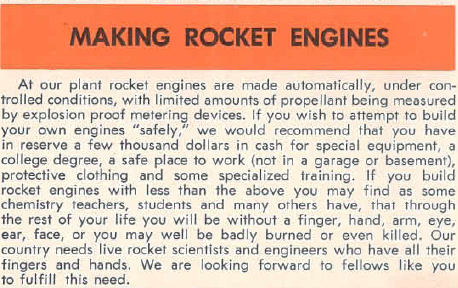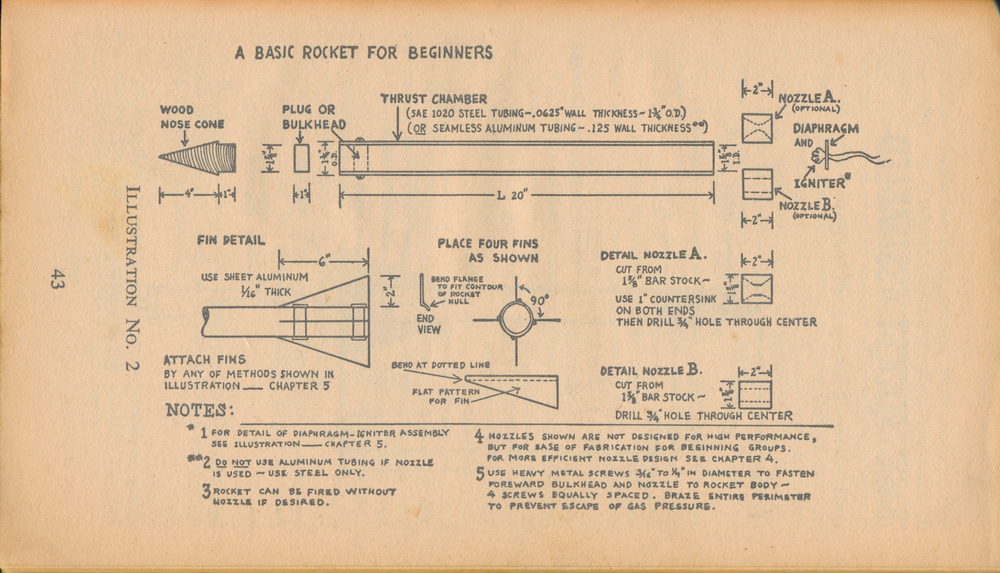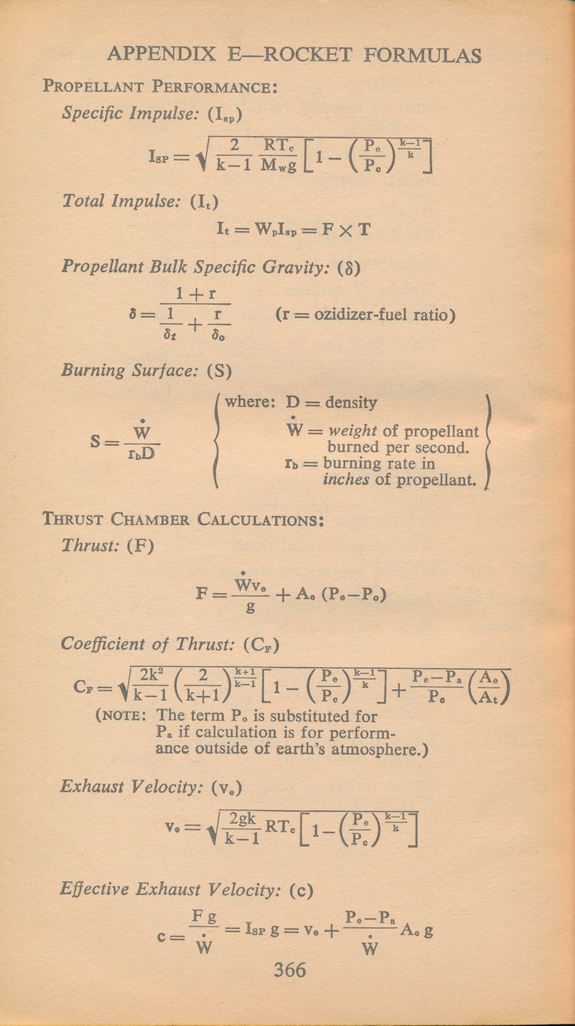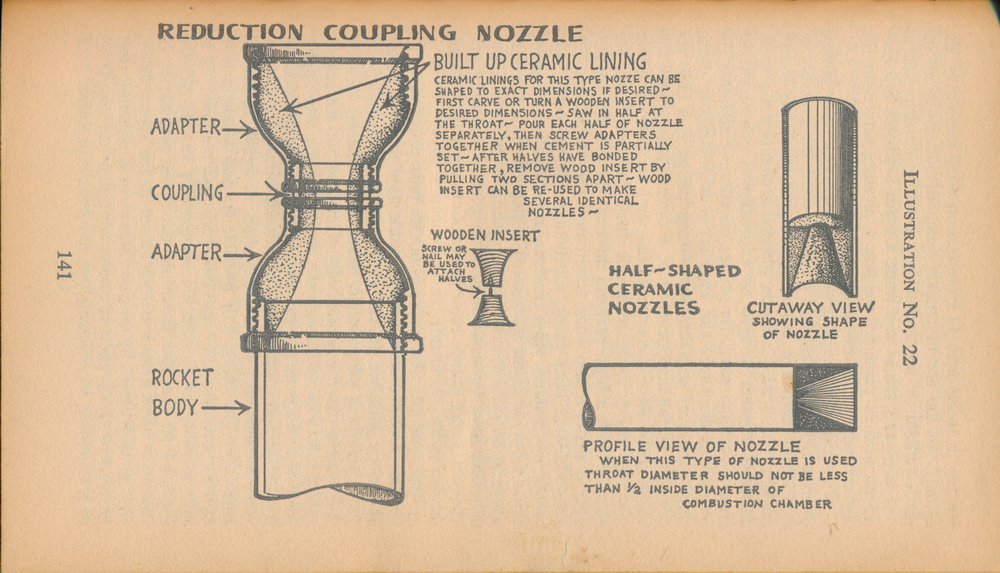


1966
Rocket Man, Part 2
The Estes rockets were fun but they were small and little more than toys, I wanted something more. Now I did notice that Estes warned about making your own rocket engines, but of course they would, I thought, they wanted you to buy their engines. Then again there was John Slade Mixson#252 who was eleven years old in 1958 when he was killed by an explosion of a home-made rocket he and his brother had made.

 But that didn’t deter me. Looking in the Popular Science I found an
ad for the “Rocket Manual for Amateurs” book which the ad said
provided full details on how to build your own rockets and rocket
engines. Ok, it sounded good so ordered the book. The book arrived
and I found it to be a serious book on amateur rockets with chapters
on the science of rockets, rocket engine design, rocket propellants,
instrumentation, launching and tracking. There was a whole appendix
with complex mathematical formulars I couldn’t understand with my
eighth grade math. The book mentioned liquid fuel rockets, but the
main focus was on solid fuel rockets which was fine with me, I
really just wanted to build a bigger version of an Estes rocket.
But that didn’t deter me. Looking in the Popular Science I found an
ad for the “Rocket Manual for Amateurs” book which the ad said
provided full details on how to build your own rockets and rocket
engines. Ok, it sounded good so ordered the book. The book arrived
and I found it to be a serious book on amateur rockets with chapters
on the science of rockets, rocket engine design, rocket propellants,
instrumentation, launching and tracking. There was a whole appendix
with complex mathematical formulars I couldn’t understand with my
eighth grade math. The book mentioned liquid fuel rockets, but the
main focus was on solid fuel rockets which was fine with me, I
really just wanted to build a bigger version of an Estes rocket.

Chapter 1, Safety and Scientific Method, I skimmed over safety
getting to the scientific method, ok the book was serious scientific
method with a whole appendix of rocket formulas,
 Chapter 1, Safety and Scientific Method, skimmed over the safety
Chapter 1, Safety and Scientific Method, skimmed over the safety
![]() I wanted to
build rockets not be a rocket scientist….errr, well maybe I did want
to be a rocket scientist, but right now I wanted to get to the good
stuff. Chapter 2, Basic Rocket Design,
now that’s better, design for a two foot high rocket sound about
right,
I wanted to
build rockets not be a rocket scientist….errr, well maybe I did want
to be a rocket scientist, but right now I wanted to get to the good
stuff. Chapter 2, Basic Rocket Design,
now that’s better, design for a two foot high rocket sound about
right,
 metal pipe with fins, a nose cone, nozzle made from pipe
couplings, all things I could get down at my local rocket supply
company, Glock’s Hardware. The nozzle I made from two pipe
fittings filled and shaped on the inside using Durham’s Rock Hard
Water Putty. Chapter 3, Rocket Propellants, the stuff that makes
the rocket go, the dangerous stuff. From Popular Science I knew the
U.S. space program all used liquid fuel rockets and that they were
large and complex, so I decided on the simpler solid fuel rocket.
Several exotic solid fuels were listed but the last one I
recognized, zinc-sulfur, the same as used in the Estes rocket
engines. No problem, I put in a request to Dad and by the end of
the week he brought me home a bottle of powered zinc and a bottle of
sulfur. I then mixed the zinc and sulfur into the appropriate
ratios and did a test lighting it on fire, well sort of, all it did
is smolder giving off a noxious sulfur smell. I tried all sorts of
zinc to sulfur ratios, but none ever worked and after a few weeks I
gave up and moved on to my next project.
metal pipe with fins, a nose cone, nozzle made from pipe
couplings, all things I could get down at my local rocket supply
company, Glock’s Hardware. The nozzle I made from two pipe
fittings filled and shaped on the inside using Durham’s Rock Hard
Water Putty. Chapter 3, Rocket Propellants, the stuff that makes
the rocket go, the dangerous stuff. From Popular Science I knew the
U.S. space program all used liquid fuel rockets and that they were
large and complex, so I decided on the simpler solid fuel rocket.
Several exotic solid fuels were listed but the last one I
recognized, zinc-sulfur, the same as used in the Estes rocket
engines. No problem, I put in a request to Dad and by the end of
the week he brought me home a bottle of powered zinc and a bottle of
sulfur. I then mixed the zinc and sulfur into the appropriate
ratios and did a test lighting it on fire, well sort of, all it did
is smolder giving off a noxious sulfur smell. I tried all sorts of
zinc to sulfur ratios, but none ever worked and after a few weeks I
gave up and moved on to my next project.
Most of the Estes rockets I built I later blew up using them to make fireworks. I packed the payload with different colored flash chemicals I mixed up along with a few firecrackers with a cherry bomb for a nose cone and off they would go, shooting up, a quick flash and a boom. I still have a few Estes rockets, two I built as a kid but never have flown, the space shuttle I built before the space shuttle program ended in 2011.
Updated: 09-13-2022